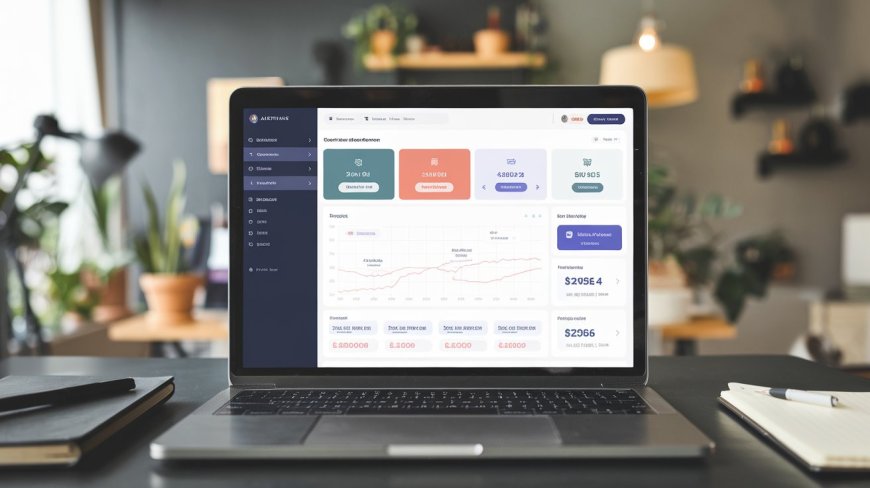Affiliate Marketing: Earning Commissions Online
Affiliate Marketing: Earning Commissions Online What is Affiliate Marketing? Explanation of how affiliate marketing works. Choosing a Niche: How to find a profitable niche that aligns with your interests and expertise. Selecting Affiliate Programs: How to choose the right affiliate networks and programs. Building a Website or Blog: A guide to creating a platform for your affiliate marketing efforts. Creating High-Converting Content: Tips on writing reviews, comparisons, and guides that drive sales. Promoting Affiliate Links: Strategies for using SEO, social media, and email marketing to promote your affiliate links. Analyzing and Optimizing Performance: How to track your results and optimize your strategy for higher earnings.



Affiliate marketing is one of the most popular and accessible ways to earn money online. It involves promoting products or services offered by other companies and earning a commission on any sales made through your referral. This method of online income can be incredibly lucrative when done correctly, offering the flexibility to work from anywhere and the potential for passive income. In this section, we will explore the key components of affiliate marketing, from choosing a niche to optimizing your performance.
What is Affiliate Marketing?
Affiliate marketing is a performance-based marketing strategy where an individual, known as an affiliate, earns a commission by promoting a company’s products or services. The process typically involves the following steps:
-
Affiliate Joins a Program: The affiliate signs up for an affiliate program, which provides them with unique affiliate links or codes.
-
Affiliate Promotes the Products: The affiliate promotes these products or services through various online channels, such as websites, blogs, social media, or email marketing.
-
Customer Makes a Purchase: When a customer clicks on the affiliate’s link and makes a purchase, the transaction is tracked by the affiliate program.
-
Affiliate Earns a Commission: The affiliate earns a commission, which is a percentage of the sale or a fixed amount, depending on the terms of the program.
Affiliate marketing is attractive because it requires minimal upfront investment and allows individuals to earn money by leveraging their content, influence, or expertise.
Choosing a Niche
Choosing the right niche is a critical step in affiliate marketing success. A niche is a specific segment of a market that you focus on. Here’s how to find a profitable niche that aligns with your interests and expertise:
-
Identify Your Interests and Passions: Start by considering your interests, hobbies, and areas of expertise. Affiliate marketing requires consistent content creation, so choosing a niche that you are passionate about will make the process more enjoyable and sustainable.
-
Research Market Demand: Use tools like Google Trends, keyword research tools, and market research reports to assess the demand for your chosen niche. Look for niches with a healthy balance of demand and competition.
-
Evaluate Profitability: Consider the profitability of the niche by analyzing potential commission rates and average order values. Niches related to finance, health, technology, and luxury goods tend to offer higher commissions.
-
Analyze Competition: Investigate the competition within your chosen niche. High competition can be a sign of a profitable niche, but it also means you’ll need to differentiate yourself to succeed. Consider finding a sub-niche where you can stand out.
-
Consider Audience Targeting: Think about the audience you’ll be targeting. A well-defined audience will help you create content that resonates and converts. Consider demographics, interests, and pain points that your content can address.
Selecting Affiliate Programs
Once you’ve chosen a niche, the next step is to select affiliate programs that align with your niche and offer good earning potential. Here’s how to choose the right affiliate networks and programs:
-
Research Affiliate Networks: Affiliate networks act as intermediaries between affiliates and companies. Popular networks include Amazon Associates, ShareASale, ClickBank, and Commission Junction. These networks offer a wide range of products and services across various niches.
-
Evaluate Commission Structures: Different affiliate programs offer different commission structures. Some pay a percentage of the sale, while others offer fixed rates. Choose programs that offer competitive commissions and align with the value of the products or services.
-
Check for Cookie Duration: Cookie duration refers to the length of time a customer’s purchase will be attributed to your referral after they click your link. Longer cookie durations increase the likelihood of earning a commission, especially for higher-priced items that require more consideration time.
-
Assess Product Quality and Reputation: Promote products that you believe in and that have a good reputation. High-quality products will lead to satisfied customers and reduce the likelihood of returns, which can affect your commissions.
-
Look for Recurring Commissions: Some affiliate programs offer recurring commissions for subscriptions or services. This can create a steady stream of income as long as the customer remains subscribed.
-
Evaluate Payout Terms: Consider the minimum payout threshold and payment methods offered by the affiliate program. Some programs require you to earn a certain amount before you can withdraw your earnings, so choose programs with favorable payout terms.
Building a Website or Blog
A website or blog is a crucial platform for your affiliate marketing efforts. It serves as a hub where you can publish content, promote affiliate products, and engage with your audience. Here’s a guide to creating a platform for your affiliate marketing:
-
Choose a Domain Name and Hosting: Select a domain name that is relevant to your niche and easy to remember. Purchase hosting from a reliable provider to ensure your website is fast and secure.
-
Set Up Your Website: Use content management systems (CMS) like WordPress to build your website. WordPress is popular for its flexibility, ease of use, and availability of plugins that enhance functionality. Choose a theme that is responsive, user-friendly, and visually appealing.
-
Create Essential Pages: Your website should include essential pages such as Home, About, Contact, and Privacy Policy. These pages establish trust and provide visitors with important information about your site and business.
-
Start a Blog: A blog is where you’ll publish content that attracts visitors and drives traffic to your affiliate links. Write about topics that are relevant to your niche and provide value to your audience.
-
Optimize for SEO: Search engine optimization (SEO) is vital for attracting organic traffic. Use relevant keywords, optimize your meta tags, and create high-quality content that answers your audience’s questions.
-
Set Up Analytics: Install tools like Google Analytics to track your website’s performance. Monitoring traffic, bounce rates, and conversions will help you refine your strategy over time.
Creating High-Converting Content
Content is the backbone of affiliate marketing. Creating high-converting content is essential for driving sales and earning commissions. Here are tips on writing reviews, comparisons, and guides that drive sales:
-
Write Honest Reviews: Product reviews are a powerful tool for affiliate marketing. Write detailed, honest reviews that highlight both the pros and cons of the product. Include personal experiences, if possible, to build credibility.
-
Create Comparison Articles: Comparison articles, such as “Product A vs. Product B,” help readers make informed decisions. Highlight the differences, benefits, and drawbacks of each product, and include your affiliate links for both.
-
Publish How-To Guides: How-to guides and tutorials are educational and provide value to your audience. For example, if you’re in the tech niche, a guide on “How to Build a Website” could include affiliate links to hosting services, themes, and plugins.
-
Use Visuals: Incorporate high-quality images, infographics, and videos to make your content more engaging. Visual content can help explain complex ideas and increase the likelihood of conversions.
-
Include Call-to-Actions (CTAs): Every piece of content should include clear call-to-actions that encourage readers to click on your affiliate links. Phrases like “Buy Now,” “Learn More,” or “Check Price” can guide readers towards making a purchase.
-
Update Content Regularly: Keep your content fresh and relevant by updating it regularly. Update product information, check for broken links, and add new insights to keep your audience engaged and informed.
Promoting Affiliate Links
Promoting your affiliate links is crucial for driving traffic and increasing conversions. Here are strategies for using SEO, social media, and email marketing to promote your affiliate links:
-
SEO for Affiliate Marketing: Optimize your content for search engines to attract organic traffic. Use relevant keywords, build backlinks, and focus on creating valuable content that answers search queries.
-
Leverage Social Media: Share your content and affiliate links on social media platforms like Facebook, Instagram, Twitter, and Pinterest. Engage with your audience, join relevant groups, and participate in discussions to increase your visibility.
-
Use Email Marketing: Build an email list and send regular newsletters to your subscribers. Include affiliate links in your emails, along with valuable content that keeps your audience engaged. Email marketing is an effective way to nurture leads and drive sales.
-
Create YouTube Videos: YouTube is a powerful platform for affiliate marketing. Create videos that review products, offer tutorials, or provide valuable insights related to your niche. Include affiliate links in the video description and verbally encourage viewers to click.
-
Participate in Online Communities: Join online forums, communities, and groups related to your niche. Share your expertise and include affiliate links where appropriate. However, be mindful of the community rules to avoid being seen as spammy.
-
Run Paid Advertising: If you have a budget, consider running paid ads on platforms like Google Ads or Facebook Ads. Target specific demographics and interests to reach potential buyers and drive traffic to your content.
Analyzing and Optimizing Performance
Tracking your results and optimizing your strategy is key to long-term success in affiliate marketing. Here’s how to analyze your performance and make data-driven decisions:
-
Track Affiliate Link Performance: Use tracking tools to monitor the performance of your affiliate links. Most affiliate programs provide analytics, but you can also use tools like Pretty Links or ThirstyAffiliates to track clicks, conversions, and earnings.
-
Analyze Traffic Sources: Determine where your traffic is coming from and which sources are most effective at driving conversions. Focus on the channels that bring in the most qualified traffic.
-
Monitor Conversion Rates: Keep an eye on your conversion rates to understand how well your content is performing. A low conversion rate may indicate that your content isn’t resonating with your audience or that your CTAs need improvement.
-
Optimize Content: Continuously optimize your content based on performance data. Update older posts, test different CTAs, and experiment with different content formats to see what works best.
-
Test and Experiment: Don’t be afraid to try new strategies and experiment with different approaches. A/B test different headlines, layouts, and promotional methods to identify the most effective tactics.
-
Set Goals and Track Progress: Set specific, measurable goals for your affiliate marketing efforts, such as increasing traffic by a certain percentage or achieving a particular conversion rate. Regularly review your progress and adjust your strategy as needed to meet your goals.
By understanding these components and implementing them effectively, you can build a successful affiliate marketing business that generates consistent income and grows over time.


